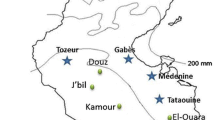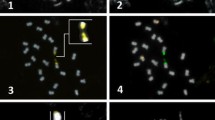Abstract
The chromosomes ofAdoxa moschatellina (2n = 36, paleo-4x) contain mostly terminal, occasionally intercalary, negatively heteropycnotic cold-induced regions which correspond to all major C-bands including the satellites, as revealed by sequential analysis. Positively C-stained are also centromeres, the dotlike arms of the 7 telocentric chromosome pairs, and some very narrow intercalary bands; their cold-sensitivity is hardly traceable. There exists a fraction of condensed interphase chromatin, at least after chilling, which is virtually not C-banded (possibly condensed euchromatin).
The DNA amount is 14.3 pg (1 C). The heterochromatin content is 13.0%. The thermal melting profile (Tm corresponding to 38.6% GC) does not reveal a particular AT- or GC-rich fraction. Significantly, the heterochromatin respond to the Hy-banding procedure is neutral.
The distribution of cold-sensitive regions in plants was analysed with the “arm-frame method”: Intercalary positions, clearly, are not especially favoured regions. The obvious deficiency at centromeric positions may depend on the action of natural selection against mechanically labile centromeric regions.
Similar content being viewed by others
References
Barlow, P. W., 1977: Determinants of nuclear chromatin structure in angiosperms. — Ann. Sci. Nat., Bot. biol. vég., 12e sér.,18, 193–206.
Baumann, T. W., 1971: Heterochromatin und DNS-Replikation beiScilla sibirica. — Exp. Cell Res.64, 323–330.
Bennett, M. D., Smith, J. B., 1976: Nuclear DNA amounts in angiosperms. — Phil. Trans. Roy. Soc. London,B, 274, 227–274.
Boothroyd, E. R., Lima-de-Faria, A., 1964: DNA synthesis and differential reactivity in the chromosomes ofTrillium at low temperature. — Hereditas52, 122–126.
Darlington, C. D., La Cour, L. F., 1938: Differential reactivity of the chromosomes. — Ann. Bot.2, 615–625.
, 1940: Nucleic acid starvation of chromosomes inTrillium. — J. Genet.40, 185–212.
Delay, C., 1946/48: Recherches sur la structure des noyaux quiescents chez les phanérogames. — Rev. Cyt. Cytophysiol. Vég.9, 169–223,10, 103–229.
Dyer, A. F., 1963: Allocyclic segments of chromosomes and the structural heterozygosity that they reveal. — Chromosoma (Berl.)13, 545–576.
Fedorov, A. A. (Ed.), 1969: Chromosome numbers of flowering plants. — Leningrad: Akademija Nauka SSSR.
Geitler, L., 1940: Temperaturbedingte Ausbildung von Spezialsegmenten an Chromosomenenden. — Chromosoma1, 554–561.
Greilhuber, J., 1974: Hy-banding: A new quick technique for heterochromatin staining in plant chromosomes. — Naturwiss.61, 170–171.
, 1975: Heterogeneity of heterochromatin in plants: Comparison of Hyand C-bands inVicia faba. — Pl. Syst. Evol.124, 139–156.
, 1976: C-banded karyotypes in theScilla hohenackeri group,S. persica, andPuschkinia (Liliaceae). — Pl. Syst. Evol.126, 149–188.
, 1978: Quantitative analyses of C-band karyotypes, and systematics in the cultivated species of theScilla siberica group (Liliaceae). — Pl. Syst. Evol.129, 63–109 (1978).
Hara, H., 1956: Contributions to the study of vegetations in the Japanese plants closely related to those of Europe or North America. Part 2. — J. Fac. Sci. Univ. Tokyo, sect. III, Bot.,6, 343–391.
La Cour, L. F., 1951: Heterochromatin and the organisation of nucleoli in plants. — Heredity5, 37–50.
, 1974: Fine structure and staining behaviour of heterochromatic segments in two plants. — J. Cell Sci.14, 1–17.
Levan, A., 1942: Studies on the meiotic mechanism of haploid rye. — Hereditas28, 177–211.
Lima-de-Faria, A., 1976: The chromosome field. III. The regularity of distribution of cold-induced regions. — Hereditas83, 139–152.
Mandel, M., Marmur, J., 1968: Use of ultraviolet absorbance-temperature profile for determining the guanine plus cytosine content of DNA. Methods of Enzymology12 B, 195–206.
Marks, G. E., 1975: The Giemsa-staining centromeres ofNigella damascena. — J. Cell Sci.18, 19–25.
Marmur, J., 1961: A procedure for the isolation of DNA from microorganisms. — J. Molec. Biol.3, 208–218.
Mechelke, F., 1955: Temperaturbedingte Chromosomensegmentierung bei Sommer- und Wintergersten. — Kulturpflanze3, 127–135.
Noguchi, J., Kawano, S., 1974: Brief notes on the chromosomes of some Japanese plants. — J. Jap. Bot.49, 76–86.
Pätau, K., 1952: Absorption microspectrophotometry in irregularly shaped objects. — Chromosoma5, 341–362.
Schweizer, D., 1973a: Vergleichende Untersuchungen zur Längsdifferenzierung der Chromosomen vonVicia faba L. — Verhandl. Naturf. Ges. Basel83, 1–75.
, 1973b: Differential staining of plant chromosomes with Giemsa. — Chromosoma (Berl.)40, 307–320.
, 1976: Giemsa banded karyotypes, systematics, and evolution inAnacyclus (Asteraceae-Anthemideae). — Pl. Syst. Evol.126, 107–148.
Tschermak-Woess, E., 1963: Strukturtypen der Ruhekerne von Pflanzen und Tieren. ProtoplasmatologiaV/1. — Wien: Springer.
Utsumi, S., Takehisa, S., 1974: Heterochromatin differentiation inTrillium kamtschaticum by ammoniacal silver reaction. — Exp. Cell Res.86, 398–401.
van't Hof, J., Sparrow, A. H., 1963: A relationship between DNA content, nuclear volume, and minimum mitotic cycle time. — Proc. Nat. Acad. Sci. U.S.A.49, 897–902.
Vosa, C. G., 1976: Chromosome banding patterns in cultivated and wild barleys (Hordeum spp.). — Heredity37, 395–403.
Wilson, G. B., Boothroyd, E. R., 1944: Temperature-induced differential contraction in the somatic chromosomes ofTrillium erectum L. — Can. J. Res.22, 105–119.
Author information
Authors and Affiliations
Additional information
Dedicated to Univ.-Prof. Dr.Lothar Geitler on the occasion of his 80th birthday.
Rights and permissions
About this article
Cite this article
Greilhuber, J. C-band distribution, DNA content and base composition inAdoxa moschatellina (Adoxaceae), a plant with cold-sensitive chromosome segments. Pl Syst Evol 131, 243–259 (1979). https://doi.org/10.1007/BF00984257
Received:
Issue Date:
DOI: https://doi.org/10.1007/BF00984257




